Contents
Pigeons in legends, myths, religions personify peace, harmony, fidelity – all the highest human qualities. A pink dove is likely to evoke a feeling of tenderness, a sense of magic and a good fairy tale. The representative of this breed is an overseas bird, an ordinary person can only see it in a photo.
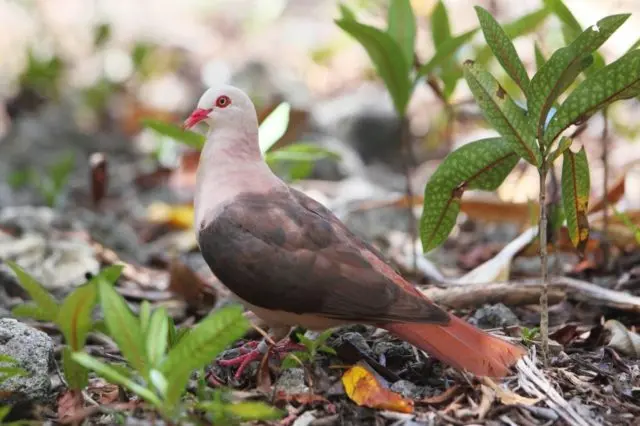
Description of the pink dove
You won’t be able to see a real pink dove somewhere on the street. Those pink birds that can be found in the squares and parks of a big city are artificially dyed this color for the sake of a human whim using food coloring or a solution of potassium permanganate. Most often, these are peacock pigeons, because with their beautiful tail plumage they look very impressive.
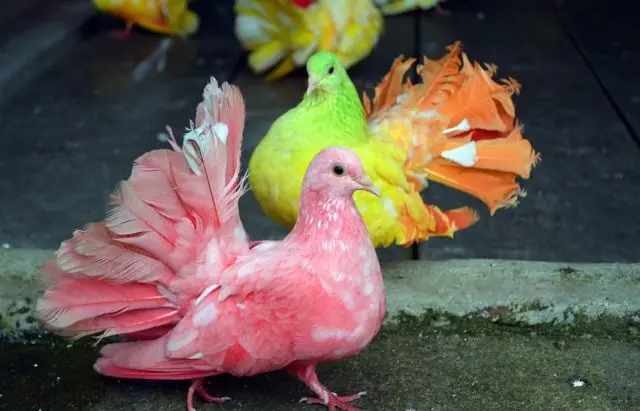
A real pink dove exists, but in nature it lives only in one corner of the globe. The bird is named so because of the color of its main plumage on the head, neck, shoulders and abdomen. It is white with a dull pink tint. You can recognize a representative of the pink pigeon family by the following description:
- the head is round, small in size, sits on a neck of medium length;
- the wings are dark, may be gray or brown;
- tail in the form of a fan, has a brown color with a red tint;
- the beak is strong with a base of a bright red color, changing to a light one towards its thickened tip;
- four-toed feet are also red in color, with strong sharp claws on the fingers;
- brown or dark yellow eyes, surrounded by a red rim;
- body length – 32-38 cm;
- weight is relatively small and can reach up to 350 g.
Pink pigeons are excellent fliers, showing virtuosity in flying over short distances. At the same time, while in the air, they usually produce a low sound “hoo-hoo” or “coo-coo”.
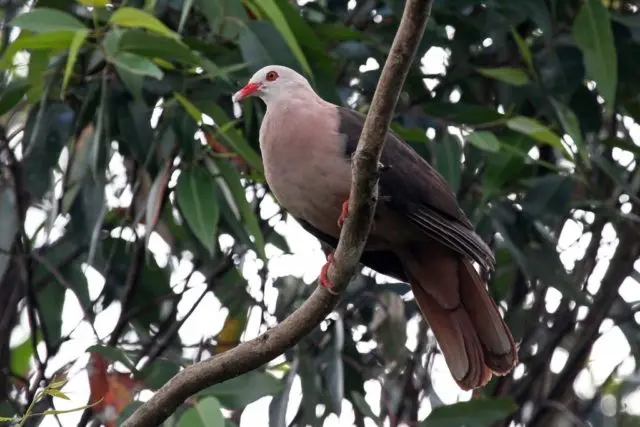
Habitat and abundance
The pink dove belongs to the endemic representatives of the fauna and lives in a very limited area. You can meet him only in the evergreen forests of the southern part of the island of Mauritius (an island nation) and on the east coast of the coral island of Egret, located in the Indian Ocean. The bird hides in the forest thickets among the vines and greenery, where there is enough food for survival and there are conditions for a more or less safe existence.
The pink dove began to be considered a rare bird from the end of the 19th century, when only a few hundred individuals remained on the planet. By the end of the 20th century, their number was reduced to ten birds. And this was the signal for urgent action to save the population. Currently, thanks to the measures taken to preserve the species, about 400 individuals live in natural conditions and about 200 in captivity.
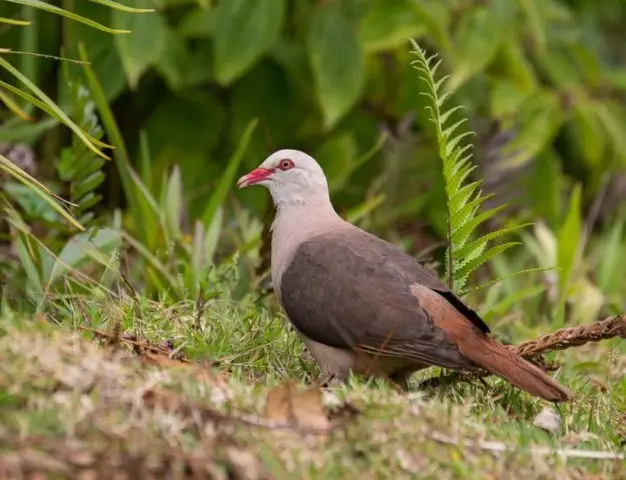
Pink dove lifestyle
Pink pigeons live in small flocks of about 20 individuals. At sexually mature age, they form monogamous pairs for reproduction, remaining faithful to each other for life. The mating season in natural conditions takes place once a year, in August-September. Mating and laying eggs are also once a year. In the zoos of the Northern Hemisphere, this process occurs at the end of spring – the beginning of summer, and chicks can appear all year round.
Before the start of the mating season, the dove finds a nesting site. Then the female is courted with all the rituals adopted by pigeons. The male walks around the female all the time, fluffing his tail, stretching his neck and taking a vertical stance. Bends down and inflates the goiter, while cooing loudly.
After the female has accepted the male’s offer, mating takes place. Then the newlyweds together build a nest in the crown of a tree, which the dove jealously guards from other birds. The dove lays two white eggs. Both parents take part in incubation. After 2 weeks, blind chicks appear. Parents feed them bird’s milk from their crop. It is rich in protein and everything necessary for the life of newborns.
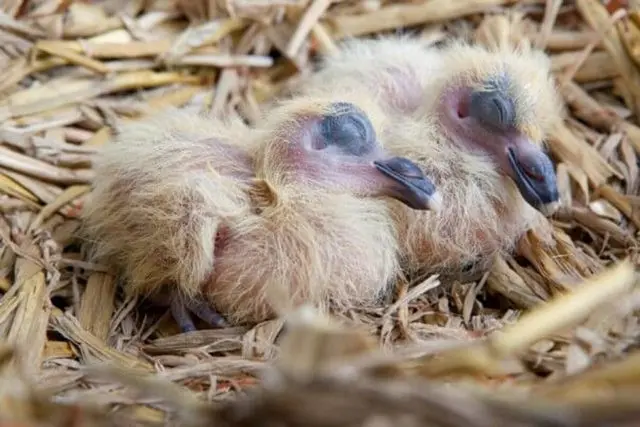
Starting from the second week, solid food is added to the diet of babies. At the age of one month, the chicks can already leave the parental nest, but remain nearby for several more months. They become sexually mature in a year, and the female – at 12 months, and the male – later by 2 months.
The nutrition of the pink dove consists of seeds, fruits, buds, young shoots, leaves of those plants that grow on the island of Mauritius. This species does not feed on insects. According to the conservation program, help centers have been created for this population, where grains of corn, wheat, oats and other crops are exposed for pigeons. In zoos, in addition, the diet of the pink dove is supplemented with greens, fruits and vegetables.
Pink pigeons live up to 18-20 years in captivity. Moreover, the female lives on average 5 years less than the male. In nature, pink doves rarely die of old age, because danger and enemies lie in wait for them at every step.
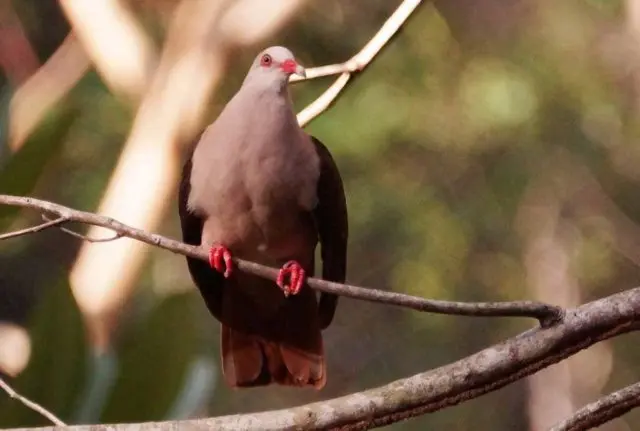
Conservation status and threats
The threat of the extinction of the pink dove from the face of the planet led to the fact that since 1977 the Darell Foundation for Conservation began to implement measures to preserve the population. Captive breeding of the pink pigeon has been set up at the Jersey Darell Wildlife Zoo and at the Mauritius Air Force. As a result, in 2001, after the pigeons were released into the wild, in natural conditions there were 350 individuals of this population.
Until now, the cause of the extinction of pink pigeons is not exactly known. Ornithologists name several possible ones, and they all come from a person:
- the destruction of tropical forests, which were the main habitat of pigeons;
- pollution of the environment by chemicals used in agriculture;
- predation of animals brought to the island by man.
The main threat to the existence of the pink dove is the destruction of nests, the destruction of clutches and chicks of birds by rats, mongooses, and the Japanese crabeater macaque. Severe storms can significantly reduce pigeon populations, as happened in 1960, 1975 and 1979.
Scientists believe that without human help, the pink pigeon population will not be able to preserve itself in natural conditions for further existence. Therefore, measures should be continued to protect birds from predators and breed them in captivity.
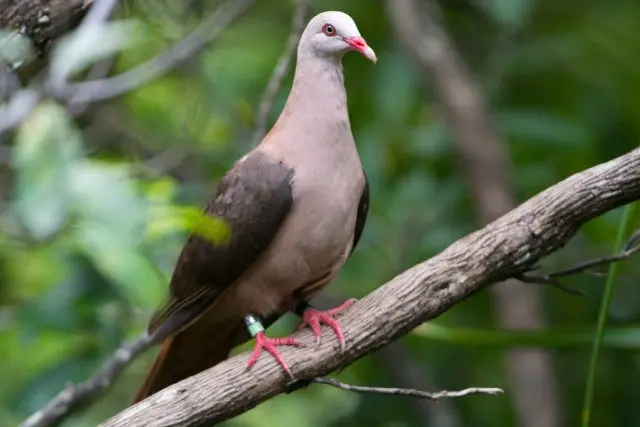
Conclusion
The pink dove is a rare bird. It is on the verge of extinction, and a person must do everything possible to preserve this population, spread it in nature as widely as possible, since it only brings harmony and adorns life on the planet.









